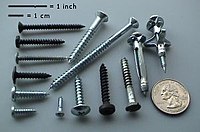
Photo from wikipedia
Abstract This study investigates the frictional influence of different rivet coatings on the joint quality and strength of self-piercing riveted aluminum alloys. A mechanically plated Zn-Sn-Al (Almac®) and an electroplated… Click to show full abstract
Abstract This study investigates the frictional influence of different rivet coatings on the joint quality and strength of self-piercing riveted aluminum alloys. A mechanically plated Zn-Sn-Al (Almac®) and an electroplated Zn–Ni coating were applied to the steel rivets to examine the frictional effect of rivet coatings. The friction properties of the rivet coatings were evaluated using a micro-mechanical surface tester. The results demonstrated that the friction properties of the rivet coatings remarkably influenced both the joint quality after riveting and the mechanical behavior of the joints. Under a similar riveting condition, owing to the lower friction coefficient, the Zn-Ni-coated rivets experienced deeper rivet head penetration and larger interlocking in terms of joint quality compared to those of Almac®-coated rivets with a higher friction coefficient. However, under a similar joint quality with respect to the appropriate riveting parameters, the joints with Almac®-coated rivets exhibited higher lap-shear and cross-tensile loads owing to the higher frictional force at the rivet/sheet interface compared to the joints with Zn-Ni-coated rivets. The surface profiles of the coatings after applying an external load using a micro-mechanical surface tester revealed a larger plastic deformation and subsequently higher delamination of the Almac® coating during the riveting process, which altered the friction properties at the rivet/sheet interface and thereby contributed to the higher lap-shear and cross-tensile loads. A numerical analysis also elucidated a significant effect of the friction coefficient at the rivet/sheet interface on the joint quality and lap-shear behavior, which is consistent with the experimental results.
Journal Title: Journal of Manufacturing Processes
Year Published: 2020
Link to full text (if available)
Share on Social Media: Sign Up to like & get
recommendations!